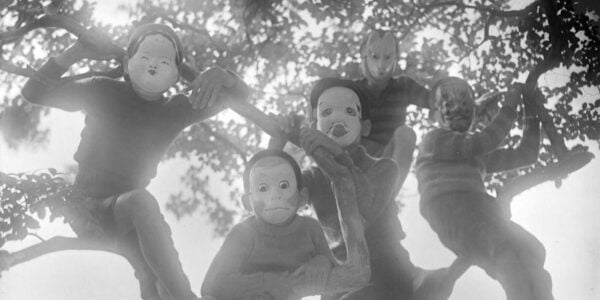Four Seasons of Children © 1939 Shochiku Co., Ltd.
Hiroshi Shimizu
Part I: The Shochiku Years
May 4 — May 19, 2024
An unsung master of Japanese cinema, Hiroshi Shimizu (1903–1966) was highly regarded by contemporaries Yasujirō Ozu and Kenji Mizoguchi for his seemingly effortless formal ingenuity, distinguished by his signature linear traveling shots and his naturalistic, open-air depictions of regional Japan. Shot on location and frequently employing non-actors, the loosely plotted, low-key tragicomedies that comprise his most characteristic work foregrounded the transient lives and hardships of everyday people with a marked regard for those pushed to the margins of society, including drifters, migrant workers, war veterans, persons with disabilities, outcast women, and especially children, in whom the director took a personal philanthropic interest and of whom he remarked: “They are natural. They breathe the air. Films must have humans who breathe the air.”
This two-part retrospective offers the first New York survey of the major yet often overlooked filmmaker in more than 30 years and the largest ever assembled in North America. Presented at the Museum, Part I: The Shochiku Years gathers the best films of Shimizu’s protean and varied career with the studio from his stark, strikingly modernist early melodramas, both silent and sound, through the lyrical tours of provincial life with which he would become chiefly associated. Highlights include the filmmaker’s best-known films in the United States (Japanese Girls at the Harbor, Mr. Thank You, The Masseurs and a Woman, Ornamental Hairpin) alongside rarer contemporaneous works that display the full stylistic and tonal range of this consummate craftsman’s accomplishments, including two of the director’s supreme masterpieces, Children in the Wind (1937) and its two-volume sequel Four Seasons of Children (1939). All films will be presented in 35mm prints imported from collections and archives in Japan.
Part II: The Postwar and Independent Years opens at Japan Society on May 16 and will illuminate Shimizu’s output after his departure from Shochiku, particularly the trilogy of films he made with the orphans he personally adopted and brought up after World War II.
Tickets for each screening program are $15 (discounted for MoMI members, seniors, students, and youth). Go to individual program pages below to purchase tickets.
See ALL of Part I: The Shochiku Years with a $130 series pass (limited availability). Present your pass upon arrival to pick up tickets for that day’s Shimizu screenings. Your spot will be held until 10 minutes prior to the start of each film.
Programmed by Edo Choi, Associate Curator of Film; Alexander Fee, Film Programmer, Japan Society; and Akinaru Rokkaku, Japan Foundation, New York
Co-organized with Japan Society; the National Film Archive of Japan; and the Japan Foundation, New York
Special thanks to Brian Belovarac (Janus Films); Mako Fukata; Hitomi Hosoda (Shochiku Co.); Kate MacKay (Berkeley Art Museum and Pacific Film Archive); Clément Rauger; Tony Stella; Kenta Tamada (National Film Archive of Japan); Yukiko Wachi (Kawakita Memorial Film Institute); Yoshio Yasui (Kobe Planet Film Archive)




















